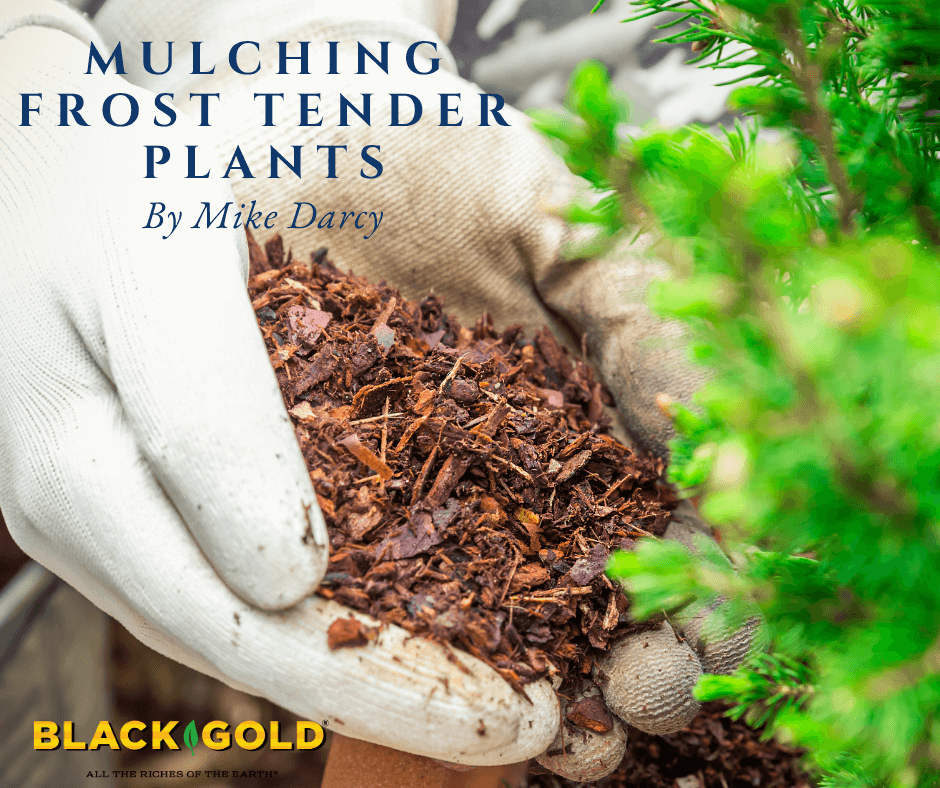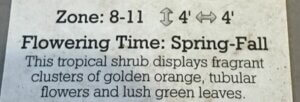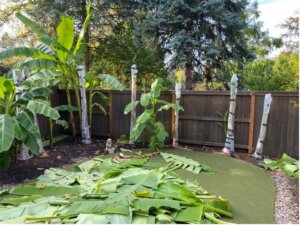
It seems as though many gardeners, including myself, are always on the lookout for a new and/or unusual plant. Even plants that might be known as not being winter-hardy are often worth a try. Gardeners living in the Pacific Northwest, and probably elsewhere as well, often use the phrase, ‘zonal denial’. This simply means that a gardener does not always have to strictly adhere to the hardiness zone on a plant label. It can be very satisfying to be able to grow a plant that is “not supposed to grow here.” For example, on the label below, the plant hardiness zone is between 8 and 11. But what if I lived in zone 7. Would the plant survive? It might survive quite well with some mulching and a little extra care.
Mulching Tips for Tender Plants

Most gardens have micro-climates which indicates that winter temperatures around plants can vary depending on the surroundings. Perhaps being up against a house would provide some protection, or a garden mulch around the base of the plant might protect the roots during the winter. Black Gold Natural & Organic Compost Blend can be used as a mulch.
The following photo shows Salvia darcyi in my garden. This is not always winter hardy and I like to give it some protection. While it bloomed most of the summer and into the fall, I knew that it needed some protection. In late November, I cut the stems to the ground and added Black Gold Perlite into the soil around the base to improve the drainage, and then added several inches of Black Gold Natural & Organic Garden Compost Blend. Hopefully, this will allow it to survive the winter.
I have mulched this Salvia for the past two years, and despite some temperatures dipping into the mid-20s, the roots have survived and new growth appears from the base each spring.

Leave the Leaves for Winter Mulch
There is a popular garden campaign to “Leave the Leaves”. We have many deciduous trees and each autumn; many homeowners hire a landscape firm to come and take the leaves away. Research has long shown that leaves can provide a huge benefit to the soil and the plants growing in it. Leaves also provide a winter home for many native insects which in the spring can provide many benefits not only to our gardens but to the environment as well. Many native bees and other insects have had difficulty surviving in barren landscapes and by leaving the leaves, we can all help to reduce this trend. In my garden, I do rake the leaves from garden pathways but have been leaving them around trees and shrubs.
It is usually wise to remove leaves from a lawn and run a lawn mower over them, it will speed up the process of them decomposing.
My neighbor has a large dahlia bed and he did not want to dig all the tubers and decided that he would leave them in the ground and mulch the bed with maple leaves. Maple leaves can be large and their leaf drop can be huge. Rather than having the leaves removed, he gathered the leaves in small piles and ran his lawn mower over them twice. Then, after cutting the dahlias back to the ground level, he mulched the entire bed with leaves. This should provide adequate winter protection for the dahlia tubers and also provide a winter home for many native insects. I told him that he took the “leave the leaves’ campaign to a higher level!

Musa basjoo is a hardy banana that will grow in our climate. It is not leaf hardy, but rather is root hardy. With a frost, the leaves will die, but the roots survive and will begin sending up new growth when warm weather returns in the spring. When the banana plant sends up new leaves, they come from the top of the stem. By wrapping the stems before a frost, the stems will be protected and, in the spring, the new growth will appear at the top of the stems and the plant will begin growing at that height. Some gardeners like to have the plants start from a 6-7 ft height and by wrapping stems, this can easily be done. This gardener used bubble wrap and then covered the bubble wrap with burlap. Some kind of wrap needs to be put over the bubble wrap because the winter sun can burn the stems through the bubble wrap, It is also important to cover the top of the stem so water cannot penetrate. The leaves will be used as a winter mulch.

There are many ways we can give our tender plants some winter protection. If plants are in pots, they can be brought indoors on nights when a freeze is anticipated. It is fun trying new plants and having some ‘zonal denial’.
